Key takeaways:
- Editing mistakes can reveal blind spots and enhance critical thinking, pushing photographers towards a more authentic creative expression.
- Common pitfalls include overexposure, color inaccuracies, and neglecting composition, which can result in unsatisfactory final images.
- Recognizing editing errors involves developing a critical eye, ensuring emotional resonance, and maintaining consistency for a cohesive visual style.
- Implementing a systematic checklist, taking regular breaks, and setting specific goals can significantly reduce editing errors and improve overall quality.
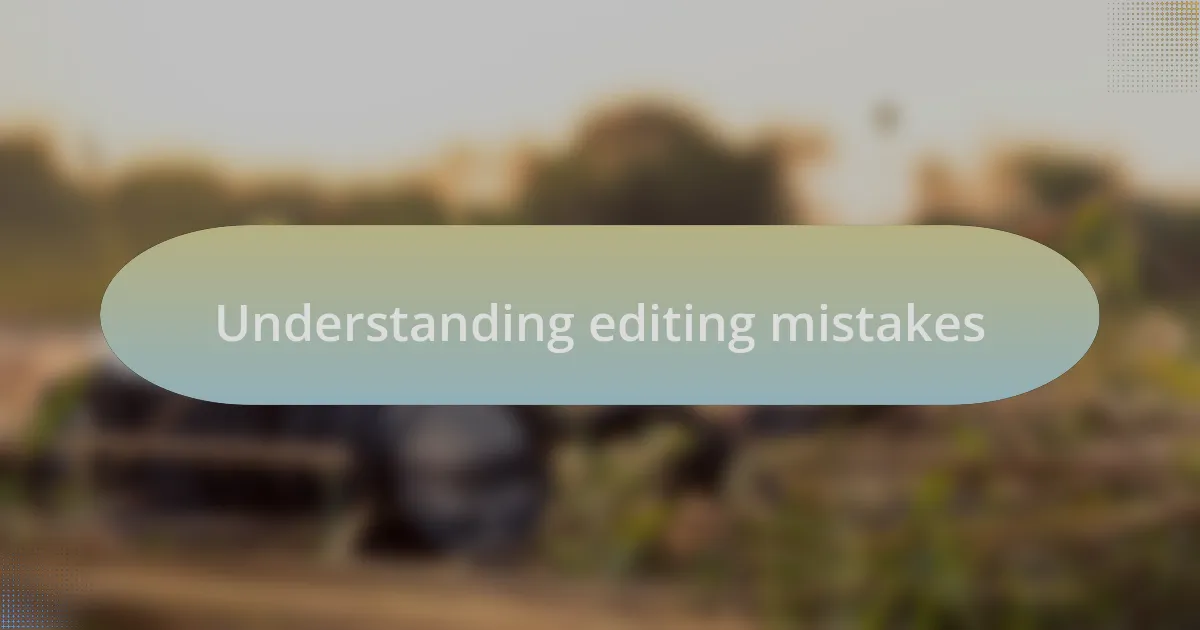
Understanding editing mistakes
Editing mistakes can often feel like a punch to the gut, especially when you’ve poured hours into crafting the perfect shot. I vividly recall a time when I over-saturated a landscape photo, turning serene colors into garish hues that just didn’t resonate with the original scene. It taught me that sometimes, less truly is more when it comes to post-processing.
Mistakes in editing can reveal our blind spots as photographers. For instance, I once overlooked a distracting element that overshadowed my subject because I was too focused on the technical adjustments. Isn’t it fascinating how the editing process mirrors our artistic vision? It challenges us to hone our critical eye and, ultimately, to become more thoughtful creators.
Have you ever noticed that editing can shape not just the image but the emotion it conveys? I remember being surprised to find that a simple light adjustment could transform a dull photo into something evocative. Those lessons showed me that editing mistakes are not just errors; they are stepping stones toward a more authentic representation of my creative expression.
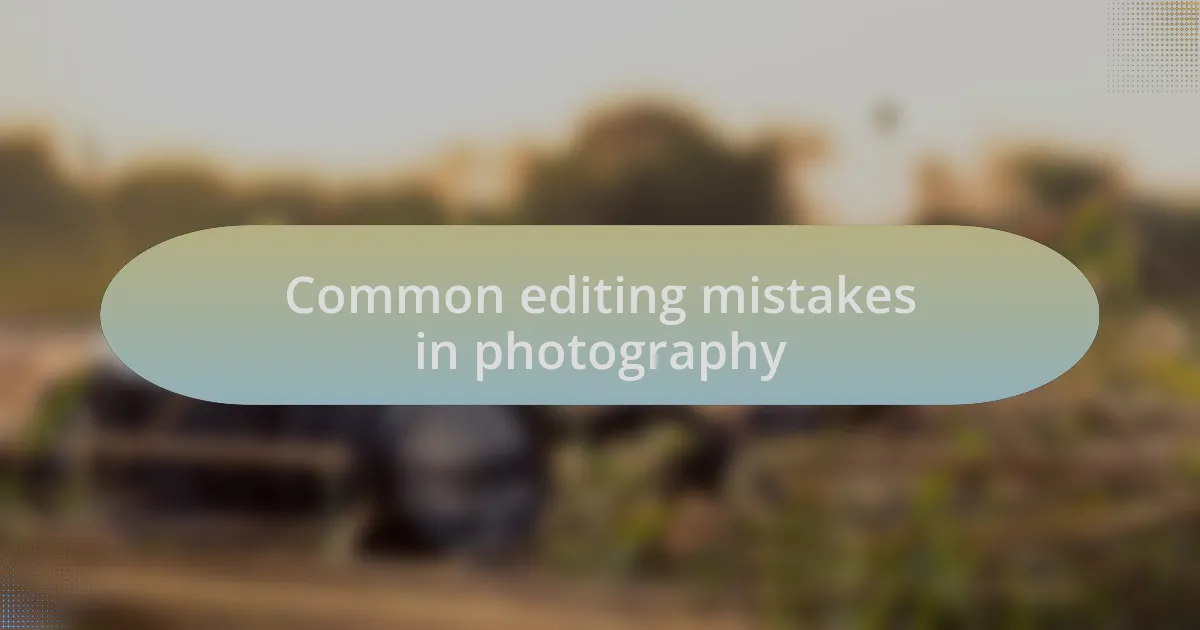
Common editing mistakes in photography
Overexposing an image is one of the most common editing pitfalls I’ve encountered. I distinctly remember brightening a portrait too much and losing all the delicate detail in my subject’s features. It was a hard lesson, but it reminded me that maintaining balance is crucial—the light should enhance, not obliterate.
Another frequent mistake involves altering colors inaccurately. Early in my editing journey, I thought I needed to tweak every color to look “perfect.” In reality, I ended up with unnatural skin tones and bizarre backgrounds. Are we really improving the image, or are we diverting from reality? That question has stayed with me as I strive for authenticity in my work.
Moreover, neglecting composition in editing is something I see often, including in my own previous work. There were times I fixed exposure issues but ignored cropping the photo to emphasize the subject better. How often do we let the distractions overpower the main story? Every time I refine my skills, I remind myself that editing should heighten the photograph’s narrative, not complicate it.
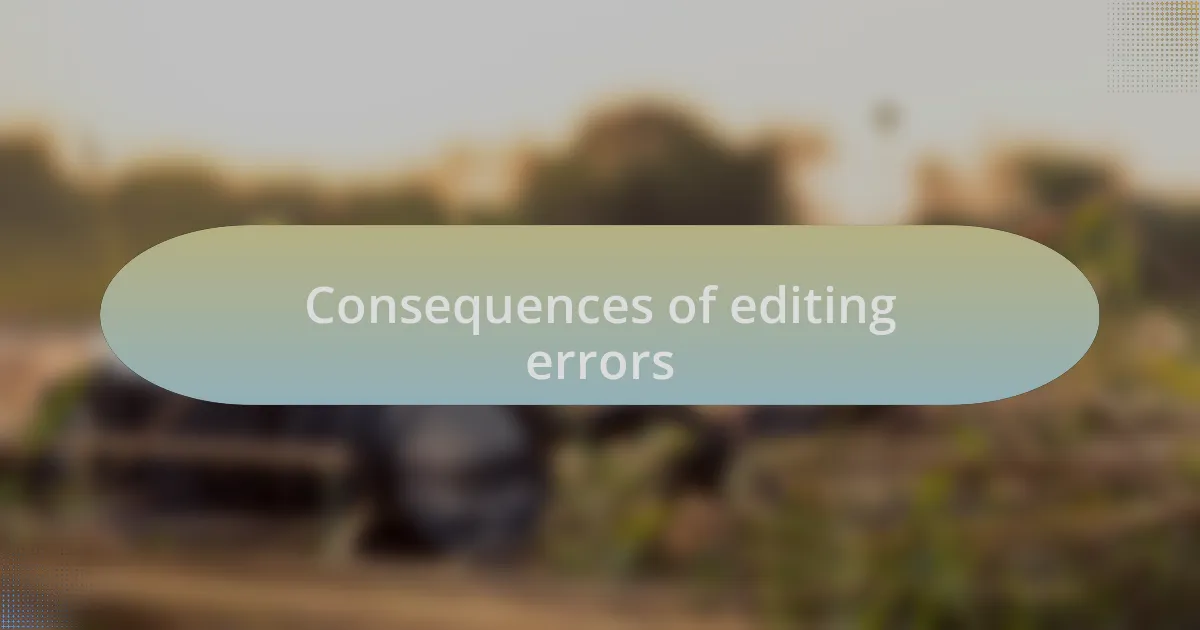
Consequences of editing errors
Editing errors can lead to a complete disconnect between the photographer’s intention and the final image. I recall a time when I mistakenly oversaturated a landscape photo, transforming a serene image into an overwhelming riot of colors. This not only detracted from the natural beauty but also made me question whether I was truly respecting the scene I aimed to capture. Why compromise the authenticity of our work?
Additionally, poorly executed edits can result in a lack of consistency across a portfolio. When I first launched my website, I quickly learned that showcasing images with varying styles and editing standards confused my viewers. Each piece should tell a cohesive story, yet my editing missteps left my audience wondering if they were viewing work from multiple photographers instead. Isn’t a cohesive visual style essential to establishing our artistic identity?
In some cases, editing errors can even damage relationships with clients or collaborators. I once delivered a set of wedding photos that had inconsistent editing styles due to careless color corrections, leading to disappointment. It made me realize how crucial it is to maintain a high standard; after all, our clients trust us to present their most cherished moments with respect and beauty. What impression are we leaving if we fail to uphold that trust?
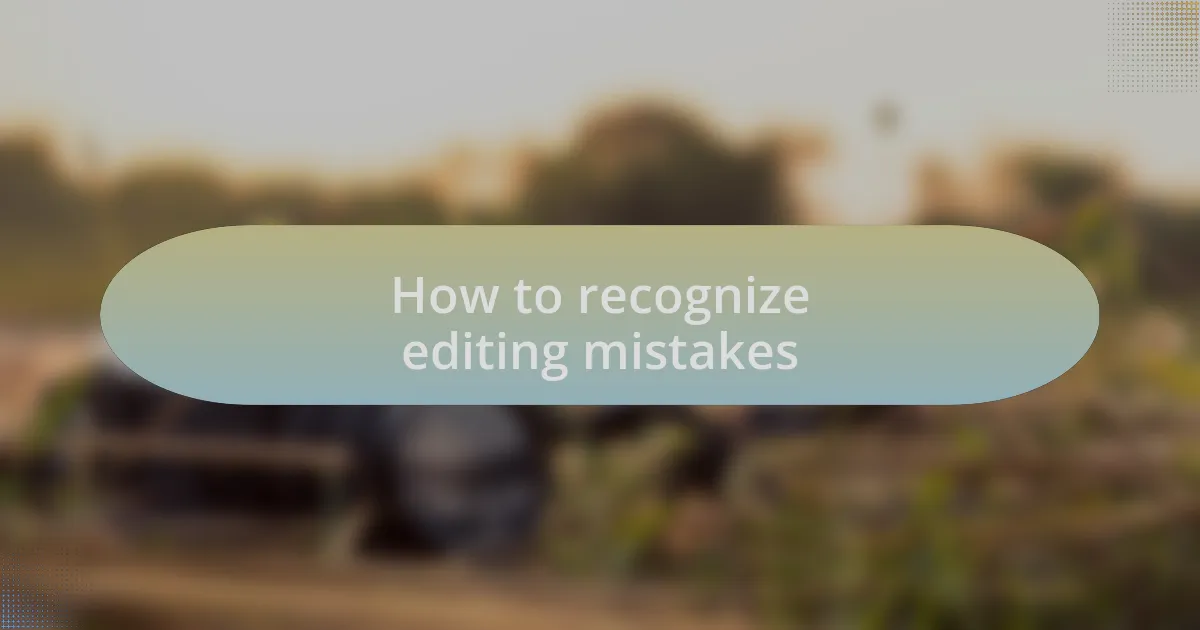
How to recognize editing mistakes
Recognizing editing mistakes often begins with developing a critical eye for your own work. I vividly recall the first time I looked at one of my images and felt something was off; the colors felt wrong, and the details seemed lost. It took a step back and some time away from the screen to finally see that I had overapplied a filter. Have you ever felt that disconnect with an image? Trust your instincts—if something doesn’t feel right, it probably isn’t.
Another key indicator of editing mistakes is when the image fails to evoke the intended emotion. I once edited a portrait that I wanted to capture warmth and joy. However, after a few rounds of adjustments, I realized it looked flat and lifeless instead. It made me question my editing choices and whether I truly understood the subject’s personality. Are your edits enhancing the emotion you want to convey, or are they dulling it down?
Lastly, consistency is critical when assessing your edits. Early in my career, I mixed various presets and adjustments in my portfolio, resulting in an erratic visual language. This disarray made it hard to identify a signature style or connect with my audience. Have you assessed your body of work lately? A cohesive editing approach not only strengthens your artistic identity but also makes a lasting impression on those who view your images.
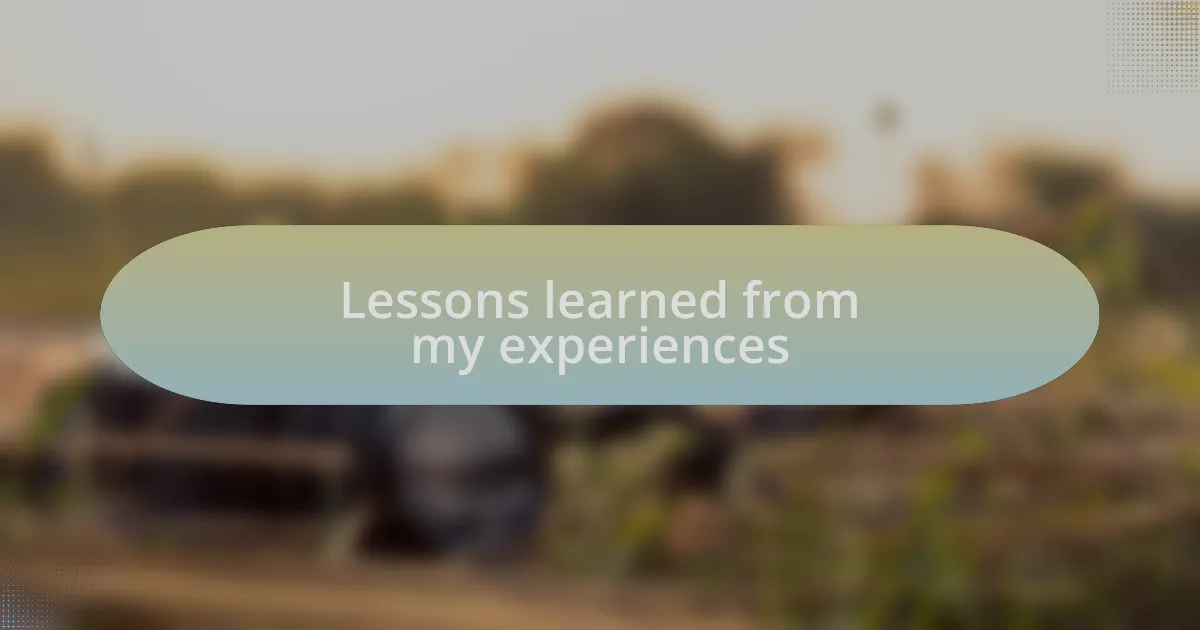
Lessons learned from my experiences
One of the most important lessons I’ve learned from my editing experiences is the value of patience. I remember a time when I was so eager to share a freshly edited photo that I rushed through the final touches. Later, when I looked at it with fresh eyes, I realized that a few extra minutes could have made a significant difference. Have you ever found yourself in that position, eager to hit “post” but then feeling regret later? Taking your time can elevate your work from good to great.
Another lesson that stands out is the importance of self-reflection in my editing process. Early on, I often neglected to ask myself why I made certain edits. There was a moment when I looked back at a series of photos that I thought were stunning, only to realize that I had been more focused on trends than my unique vision. It was a wake-up call; I needed to ensure that every edit spoke to my style. How often do we get caught up in what’s popular instead of staying true to our artistic intentions?
Lastly, I’ve learned to embrace feedback as a tool for growth. There was a time when I would shy away from sharing my work with others, fearing their criticism. However, when I finally opened up and let a trusted friend critique my images, I discovered a wealth of insights that enriched my editing skills. Have you considered the benefit of having another set of eyes on your work? Constructive feedback can illuminate areas for improvement and lead you to new creative heights.
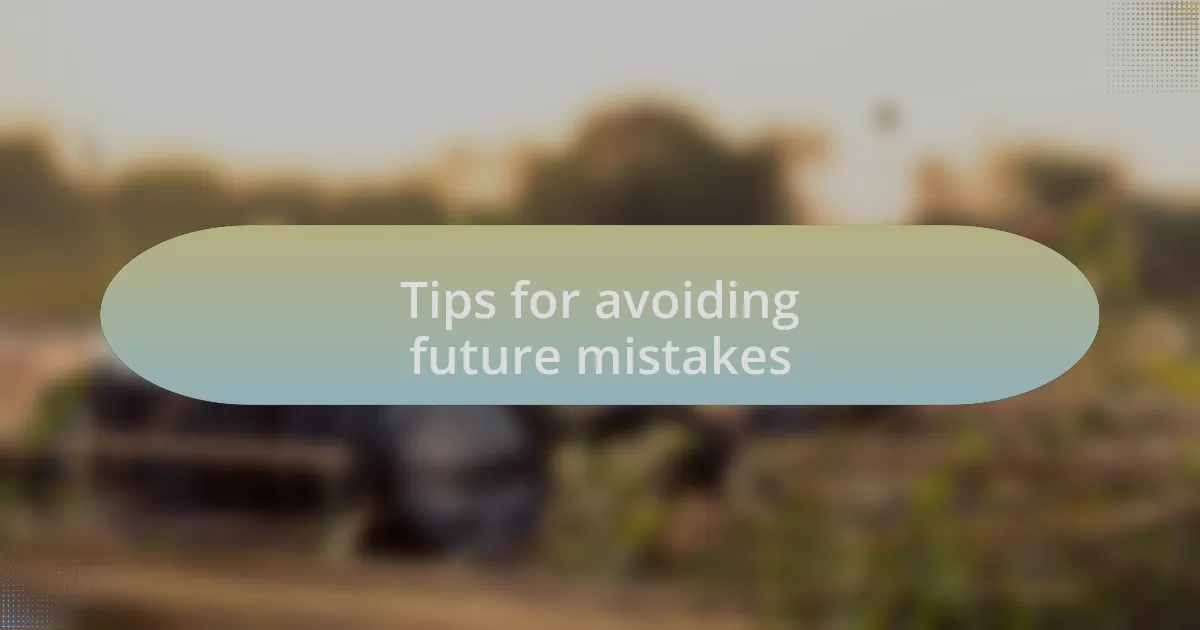
Tips for avoiding future mistakes
To avoid future mistakes in your editing process, developing a checklist can be incredibly useful. I remember creating a simple list that included key steps like color correction, cropping, and sharpening before finalizing any image. This became my go-to guide, which helped reduce the number of oversights. Have you ever considered how a systematic approach can streamline your workflow and boost your confidence in the final product?
Another effective strategy I’ve found is the importance of taking breaks during editing sessions. There were times when I edited for hours straight, only to miss glaring issues that were obvious upon returning after a short pause. Stepping away rejuvenates my perspective, allowing me to see my work with fresh eyes. How often do you find that a little distance helps you catch mistakes you might otherwise overlook?
Lastly, setting specific goals for each editing session has proven to be a game-changer for me. Instead of diving in with an aimless mindset, I now decide what I want to achieve—whether it’s mastering a new technique or refining a particular photo. This focused approach has not only minimized careless mistakes but also kept me motivated and inspired. Does your editing process have clear objectives, or do you sometimes find yourself wandering without purpose?
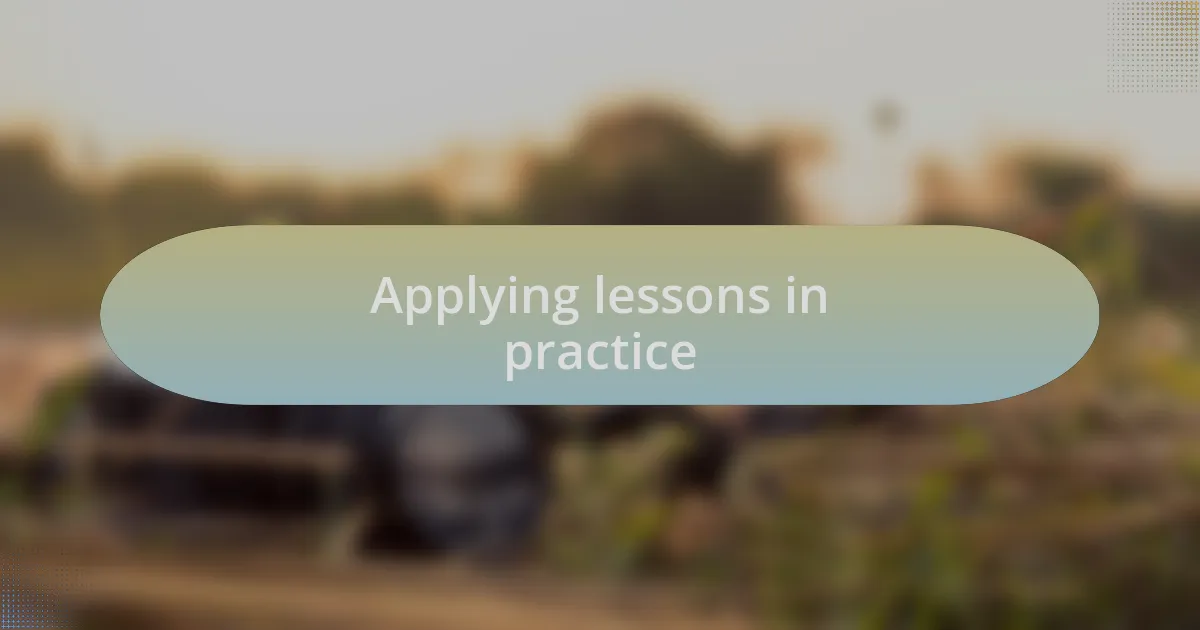
Applying lessons in practice
When it comes to applying what I’ve learned from my editing mistakes, I’ve discovered the value of documenting my process. I keep a dedicated journal where I reflect on each project and note what went right or wrong. I remember one particular project where I overlooked subtle lens distortion; by writing about it, I was able to devise a clearer method for spotting such issues in future sessions. Have you ever stopped to think how reflecting on your experiences can lead to deeper understanding and improvement?
I also found that experimenting with new techniques allows me to break free from my old habits. A few months ago, I decided to try a different editing software simply to challenge myself. While the learning curve was steep, embracing this change helped me recognize some previous mistakes that were embedded in my routine. Isn’t it exciting how stepping outside your comfort zone can lead to valuable insights?
Moreover, sharing my work with peers and seeking feedback has been a revelation. I recall a time when a fellow photographer pointed out inconsistencies in my color grading that I had completely missed. That moment not only improved my skill set but also reinforced the importance of collaborative learning. How often do you reach out for a second opinion, and what could you gain from that exchange?